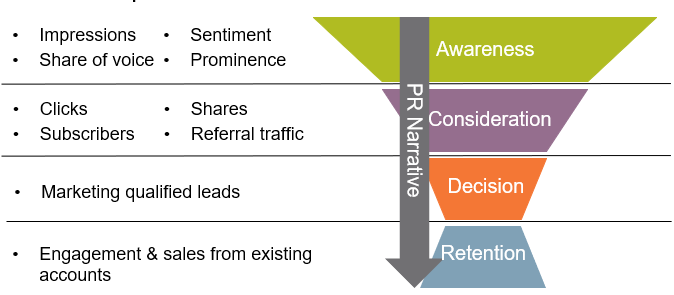The heart of the 2018 planning season is upon us. It’s easy to dread planning – being trapped in conference rooms or “offsite retreats” (if you’re lucky) for hours on end. But we hope you also embrace it as a time to reflect on what worked and what didn’t this past year – a time to reinvigorate your marketing program and start fresh with a new approach.
Your planning process will no doubt involve developing SMART goals and the key performance indicators (KPIs) you’ll track to measure progress against those goals throughout the coming year. Now is a great time to rethink how and what you’re measuring to ensure it’s aligned with the overall business objectives.
At Inprela, we are taking a new approach to the measurement of PR to include earned, owned and paid media metrics. Why? Because we know that successful B2B PR is centered on storytelling that fosters meaningful engagement, and demonstrates business value at every touch point in the buying cycle, regardless of channel.
B2B PR metrics are no longer just about brand awareness, impressions and placements. Since B2B PR is most impactful when you deploy a strong and consistent, customer-centric brand message at each stage of the buyer’s journey, we need to align and measure KPIs at each stage of the buyer’s journey to better understand what’s working and what’s not. To that end, we strongly encourage you to use the following KPIs to measure effectiveness of your 2018 PR program.
Earned media
Earned media is company publicity or endorsement by a third party, published or presented off-domain (anywhere other than your owned channels), gained through media outreach, content distribution, press releases, etc. The value of earned media is in creating top-of-funnel brand awareness and establishing a thought leadership position/positive brand reputation that leads new prospects to your owned channels and begins fostering engagement. Leads and clicks will naturally be lower at the very top of the funnel so we recommend measuring the following metrics to assess the quality of earned media:
- Placements
- Impressions
- Share of voice amongst competitors
- Sentiment
- Shares
- Referral traffic from earned media
Owned media
Owned media is the content your brand creates and publishes organically on brand-owned channels, such as your website, blog, email and social media channels. Owned media success is powered by strong content marketing and SEO strategies. Measuring owned media helps you identify what topics, mediums and distribution channels are performing well. The value of owned media is in engagement, lead capture, and nurturing leads through the funnel – not in net new lead generation. With that in mind, here are the top KPIs for measuring owned media effectiveness:
- Organic search traffic
- Top organic keywords
- Top performing content
- Engagement with owned content (clicks & bounce rates)
- Form fill-outs (sometimes called responses)
- Email subscribers
- Email or nurture stream engagement (open rates, clicks, unsubscribes)
Paid media
Paid media consists of paid advertising and sponsorships, including pay per click keyword targeting through AdWords, display advertising such as behavioral programmatic targeting and retargeting, sponsored content syndication and paid amplification of social media posts. Measurement depends on the goal of each paid channel. Here are some general pointers:
- Within paid search, cost per click and marketing qualified leads (MQLs) are important to track because paid search is typically a lower funnel tactic. Often branded and product keywords perform better than generic industry keywords in terms of leads and sales because if a user is searching for a specific a brand name, they are more likely to buy than people searching for general industry terms therefore the cost per click and cost per lead should be lower for branded terms vs. generic terms.
- Display is more of a brand awareness play and usually doesn’t result in a high volume of leads so it’s important to look at clicks and assess creative to see what’s motivating users to click.
- Engagement metrics are often the most important for paid social amplification, such as clicks, replies, shares, etc.
The ideal state of measurement is to align KPIs with stages of the sales and marketing funnel to assess the success of the brand narrative at each touch point as shown in the graphic below.
Overall marketing measurement should tell a story and help you make better informed decisions about where to invest your time and budget. Contact us to learn how to get started: connect@inprela.com.




